The spring of 2010 I began to suffer from post-imprisonment depression. I had been warned by fellow inmates that this would happen but didn’t believe it until it happened. Those inmates who I befriended and who had been incarcerated before had all suffered from this and all of them smiled when I claimed it wouldn’t happen to me.
I was sure of myself because I had previously undergone therapy with a very skilled therapist and had acquired skills to deal with my own feelings. Thus I was confident that depression would never get hold of me again. Boy was I wrong.
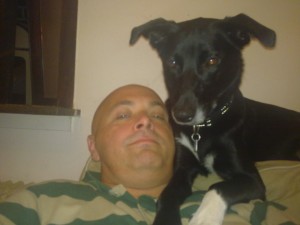
Two months into my freedom I felt just fine, but in a matter of days I felt surge of negative emotions overwhelm me. It took me eight months to start feeling normal again, and five more months to fully get back on my feet.
The moment depression hit me I made two or three fundamental decisions. First decision was not to deny what whas happening, instead to let it sweep me away into a inner journey in the hope that I would be able to conquer the roots of those feelings. My ambition was never to get depressed again. Second decision was, as I was unemployed at the time, to use the unemploymency to self-analyze myself, my skills and desires, and redevelop my professional path. A decision which javascript:;has been very hard to keep true, but still been rewarding. The third decision was not to train any dogs while being depressed.
My experience with dog training has taught me that accomplishment and rewards go hand in hand with mental and emotional state of the trainer. I felt if I would use my depressed state as a vehicle for a dogs growth I might risk the outcome in a unforeseen way. I didn’t want to risk teaching a dog to take in my depression or my sadness or sorrow.
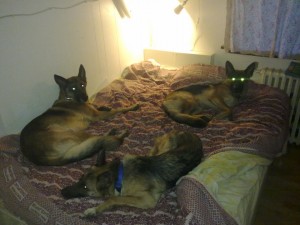
All my dogs have maintained friendliness towards strangers at all times and they are all enthusiastic about work. It’s worth mentioning that Káta isn’t keen on children, and it is suspected that something happened to her before she came to me around four months old. I didn’t want to risk any imbalance in this matter so I opted out of obedience training except for basics.
Of course it was out of the question to stop SAR training. The same principle applies in that respect but there is a fundamental difference when it comes to my pack. Those of my dogs which had already begun the SAR simply loved it and all of them excelled at their levels, and still do. What I decided was to keep them at their levels, not to push them forward but keep steady. As the dogs love this work with a passion and since I love it as well, there was never a bad or negative emotion involved. The only threshold was the willingness from my part to push forward and extend their boundaries.
There was also another consideration. As I am a primary instructor in these training sessions with www.hundasport.is there was no question that I must attend as much as possible. The principle of instruction is very basic, yet very delicate and requires skill. The instructor must be exceptionally focused on the dogs in every session and he must accumulate his knowledge or understanding of each dog-person involved. Also he must have keen insight into the emotional state, development and focus, of every human individual who attends. He must be able to bring his insight into both the dog and his human handler into a harmony where he can successfully guide them together towards a common goal as a team.

There are other teams who train SAR dogs, and I have trained with some of them. It is tempting to go into the difference between focus, philosophy and methods in order to facilitate a more positive opinion on my group in regard to others. Tempting as it is, I must refrain as the others are much better at it.
SAR training is one of the arms of dog culture where the training has more to do with art than science. Obedience training or K-9 (Schutshund) is different and has more to do with technique and robotic response methods. Walking on heel is a technical response, so is sit, lay down, roll over, stay, wait, come, follow, turn, whatever.
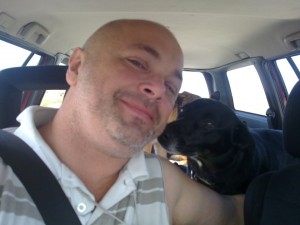
Schutshund is more like Obedienced on steroids where it has been taken a step further with discipline. Though Birta is taking some steps towards this training it is more because I have enough dogs working in the SAR group and feel that I should prove my attitude with at least one dog. Also she has the perfect attitude for Schutzhund. She is higly intelligent, very focused, strong willed, a bit regal, and at the same time totally harmless. She is a perfect candidate for a well trained Schutzhund.
SAR involves a few things. First a dog must realize the difference between walking with his leader in a country side or running around searching for a lost person in a country side. He must decide by himself how it would be best to accomplish the search and also be able to take directional hints. Therefore the dog must have keen insight, he must trust his handler, and mostly the handler has to trust his dog explicitly. Obviously the dog must have independence enough to be able to make decisions on his own and at the same time be obedient when needed. This is one of the reasons why German Shepherd are less suited for this than say Labrador Retriever or Border Collie.
The German Shepherd (Sheffer) is intelligent enough to develop this far, but they like routine more than the others. Once they make up their minds i.e. which technique or method to use, they don’t let go of it to easily. On the other hand, these are traits which come very useful in drug searches or Schutzhund. It is also common with this breed that they don’t like to go to far away from their leader or pack and therefore they tend to take very small search areas. Add to this, that handlers of Sheffers like to keep them close and therefore have tendency, often unaware, to encourage the closeness. These traits are easily overcome and I did so quickly with Ljúfur. He has successfully broken the traditional boundaries of Sheffers when it comes to SAR.

Once a dog has found his subject, figurant, he must decide to let his handler know of it. Not only that, he must do so in a clear message which cannot be misunderstood. Then he must show his handler where the subject is, and if necessary be willing or ready to resume the search if others are missing. In the whole process, which can take quite some time in a real life search and rescue, the dog must be focused the whole time and be able to handle easily all these complicated but intervowen tasks. Or process.
As described, it is obvious that SAR training, which can easily take two and up to four years, requires diligence, insight, skill, self-understanding and patience. Technique has little to do with success here as personal interest, skill and self assurance has more to do with it. All in all, successful SAR trainers are more like artists than technicians. It goes without saying, that being a SAR trainer myself, I have a passion for this artform and not only skill but have acquired a level of competence which has enabled me to successfully guide others and even pass my skills of guiding onto others.
For all of these reasons it is probably obvious that taking a break, even for months, was not an option for me or for my dogs. Particularly when considering Salka and Ljúfur. They are both excellent in this field and have even with minimal preparation been able to work a search area together as a team with me as a handler. Ljúfur has also proven himself, in his middle aged years, to be able to work a field with another handler with no preparation and regardless of intrusion into the search both by me and also by the other handlers dog. He is simply amazing.
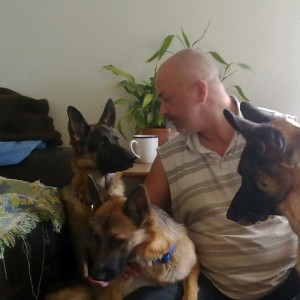
This is the reason I decided to keep SAR training alive though I was severely depressed and felt unable to develop my usual home-training with the dogs. It pained me at times to maintain this decision but every time I tried to break away with it I realized the need to stay put. Through the months I attended SAR sessions, helped members of my group, taught and guided, and the group continued successfully on their path. Some war stories from that year are amazing and it is tempting to stray into them. But alas, another time perhaps.
My dogs, Ljúfur and Salka, continued step by step in SAR, they kept their stance and incrementally improved themselves. I had no time to keep Káta going so she has slided but before that she was excellent in tracking, promising in field search and very good in snow-avalanches. As stated before, Birta’s ambition is Schutzhund, so she hasn’t been introduced to SAR. But! She has alwasy accompanied the pack to sessions and been able to meet the other dogs and play with them.
At some point I decided that perhaps she should have a taste of tracking. She was at the time only fourteen months old. Her first track was perhaps ten meters. Ten days later we laid another track about fifteen meters. Then I didn’t do anything with her for two weeks. I wasn’t even considering to develop this with her. I was simply waiting for my depression to whither and for her to mature a bit and then we would begin some home training in my garden and neighborhood to lay her foundations.
One afternoon at a SAR session something happened. All dogs had finished their training, the group was reminiscing and all dogs where let out of the cars to mingle together. Birta immediately attacked me and wouldn’t let go. She jumped at me, gnawed at my sleeves, tried to pull me away from the group. She barked at me, something she hadn’t done since three months old, and in fact she was intolerable. The dog was simply out of control!
It suddenly flashed in my mind. “The dog si telling you somethin”. Now it is established in my soul, and has been since Ljúfur had been with me for a week, that when I get a flash-thought like that in my mind I tend to trust it. Every time when I do, I get success from my dog. Some people call it “dog whispering” and probably it is. It is a talent some people have in the field of dog training, and others don’t. I simply trust my hunches, listen to thoughts which cannot be mine and I trust them. Therefore I often seem to know magically what is on a dogs mind.
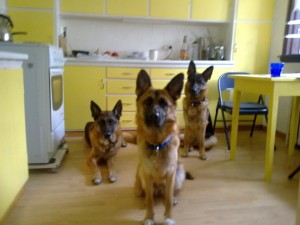
As soon as I heard this thought in my mind, I turned towards Birta and allowed her to have her will. She pulled at my sleeve and shoved me successfully a bag beside my jeep where some dog training tools and toys where kept. As soon as I saw it I realized the thought in Birta’s mind. “I want to track, play like the other dogs”. She had been watching from the car all evening and demanded to have a go.
I asked one member in the group to lay down a hundred and fifty meter track, to go out of sight and make a bend in the track. For this young dog, who only had worked twice a very short and easy track, this was a bit wild. When Birta had the track leash attached to her body harnesh she glued her nose to the ground. Very quickly she found the track and basically dragged me to the hidden figure, the one who laid the track. Afterwards she retracked searching for dog sweets which she had missed in her excitement to find the figurant. What a dog! What a true daughter of Ljúfur!
Today I’m not depressed. My Jungean trip into my inner world has proven successful and a wise decision. I have travelled through emotions, fantasies, sorrow and dreams who can render many men mad, and I have pulled through.
My dogs have been my joy and sustenance on this journey and I am still convinced that I made the right decision not to involve them in it. Knowing dogs and how they shape their own soul in accordance with their leader’s I know they have travelled with me through the land of darkness. But I still am convinced that had I trained them personally in daily routines, I would have forged something in them which wouldn’t have been good for either me or them.
I have seen so many times when training in groups that dogs try their best to pick up their owners personality, not the surface one but the roots or the inner true being of their soul. I have learnt to trust this for example when you meet a man who seems very friendly but has an unfriendly dog, you simple aren’t dealing with an honest and friendly man, but someone who is probably false and cruel backstabber. These are harsh words but keep them in mind the more you are involved with dog-people. The dog always gives away the nature of his leader!
I also have seen time and time again, when the handler doesn’t completely trust his dog in a search exercise, the dog will almost certainly fail. And when a dog owner places great emphasis on obedience he doesn’t fully trust his dog, the dog won’t trust himself and they aren’t a joyous team. Owners who mix together freedom, complicated tasks, and some obedience; Have self confidence, joyous nature and a happy dog.
There was a time when I thought that perhaps I should obedience train my dogs, even if I was depressed. I have been conflicted about this. Now I have been free from depression for a while and have begun again my basic methods of obedience training and playfulness, call it home-training.
The thing is. When you give your dog rewards, be it a game, a treat or a petting, you always mix it with your feelings and emotions. If you feel exhilaration in your heart, for a trick well done by your dog, he feels it. Whatever reward you give at that moment will be connected in his mind to that feeling. Soon you won’t need to reward a certain behaviour, as the dog will always feel if you’re exhilarated or disappointed.
The more often you take your dog aside and play with it, especially if you enjoy it, the dog will connect his feelings with yours. He will feel it if you don’t enjoy the game and he will feel that he did something wrong if you don’t share his joy. For this reason a dog will be more obedient, and less stubborn with a leader who plays often and only when he enjoys it.
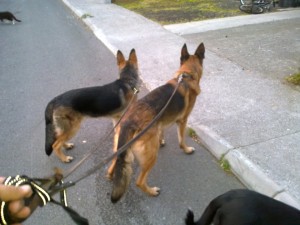
When I feel joy in my heart I do take my dogs aside for five minutes and play a little with them. They don’t care if it’s only for a few minutes, in their mind the leader calls the shots anyway. If there was joy in the game, the dog will be satisfied and he will easily accept when the game is finished.
When you’re feeling good about yourself and about your dogs you give different discipline or reward for accomplishments. If you are sad, depressed or even angry inside your soul, be it depression or just dissatisfaction with your work, you will be less rewarding and more harsh when communicating results. This might not be what you want. Especially if you keep in mind that a dog will adopt and assimilate your nature and traits. You don’t want a dog who is indifferent to happy occasions and hard, even cruel, when it comes to negative situations.
On the other hand if you only do work, games, tricks or training with the dog when feeling good in your heart the same principle applies. In my experience it gives a dog healthy positive demeanor, better willingness to work with you – or for you – and it will be easier in the long run to encourage the dog to overcome difficulties.
There are at least two other points to consider here. A dog who has an owner who is self assured and calm, will be so as well. Also there will be more opportunities to train or teach when you have a happy heart. I’ll demonstrate with “the walk”.
Actually I do most of my dog training during walks. Almost all trick which I teach my dogs are done on my walks around the neighborhood.
If you take your dog on a walk, which usually lasts from five to fifteen minutes, you’ won’t see any opportunities to do accomplishments with your dog if you’re feeling sad or negative. You’ll simply get the walk done with, peeing and pooing, and then get back inside to watch TV, browse the Net or any other private activity.
On the other hand, when feeling happy inside your demeanor will be quite different. You’ll see many opportunities and I’ll name a few examples. You’re walking to the end of the street, being sad you’d simply finish to the end of the street and then turn back. Being happy and calm inside you might pace the street at different paces or speed. You wouldn’t be in a hurry to walk back and forth and therefore you can tune your dog(s) into different pacing. You would be more inclined to communication between you and your dog and therefore be more inclined to teach something new or simply to make differences when walking. Who says you have to walk to the end of the street and then back?
You might suddenly wish to get the dog to sit down and wait while you circle around it. There is a bench in next streat, you might pass it and suddenly encourage the dog to jump on top of it. You might choose obstacles for him to jump over or go right under. You might wish to teach the do a command like “go” or “pull” when he is in front of you, or give cue for his own activities like sniffing, peeing, pooing and so forth. The ideas for activities are only limited to your own imagination and every time the dog does something positive you can give a positive reward with your voice, with your feelings. You might not have treats in your pocket but since a dog always connects with your feelings, he will be happy to have made you happy!
On the other hand, when feeling depressed you won’t see those opportunities and even if you did and used them you wouldn’t be able to give positive feeling-award to the dog. Therefore the dog would have less fun doing exercises and you wouldn’t see any point in them.

These are some of the reasons and thoughts which I used in my reasoning for doing less obedience or trick training while in my depressed state. Often I wasn’t particularly sure if I was doing the right thing. I had four dogs and by the end of this period I had five. As it goes, when you have a pack, the dogs in the pack tend to bond with each other which can be hard on their owner. Who is the leader of Birta within the pack? Who is more in command, Káta or Ljúfur? The owner can easily, and I have, found myself in a situation where general obedience was lacking. Sometimes because of low priority on obedience and sometimes because of inter-bonding in my pack.
As a general rule I wasn’t worried about this. All my dogs obey when called, named, given simple commands like jump, fetch, lay down, wait and so forth. So I simply said to myself that once depression would be dealt with I would quickly get them on track. There was a lingering doubt though, and I will always have that doubt: Would my depression have gone away quicker had I trained one dog a day through the period? It is possible but no-one will ever be able to answer that.
Any way. I’m not depressed anymore and I train them daily. Every day I take at least one dog aside and do something with it. Every day I use opportunities on my walks to do some accomplishments or reinforcements. Every day is a fun, for me and for my dogs, and we are continuing our positive journey through life. I have channeld my daily life in a such way that I can spend every waking hour with my pack. In fact when I have to leave them at home for a couple of hours and do errands in town, I feel exhilaration to come back home and meet all of them again.
Now is a good time to train.
